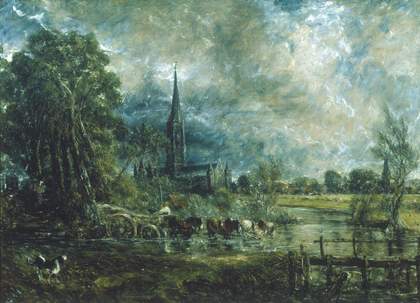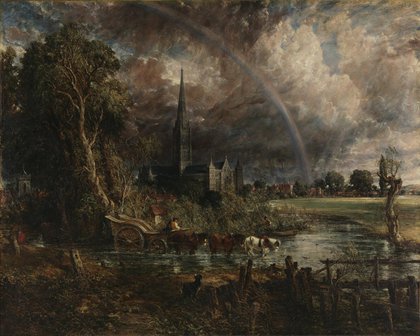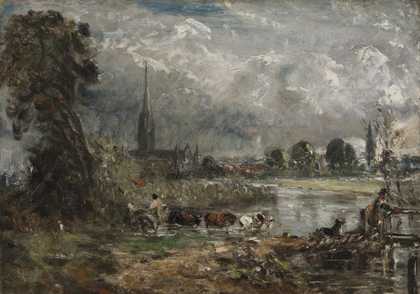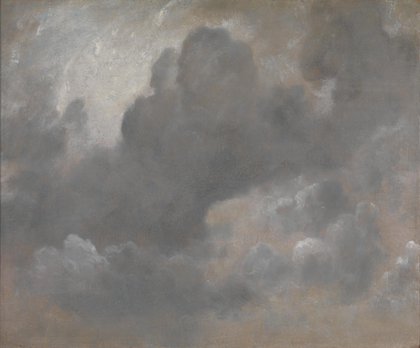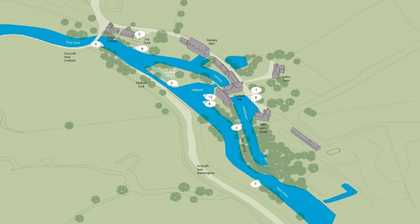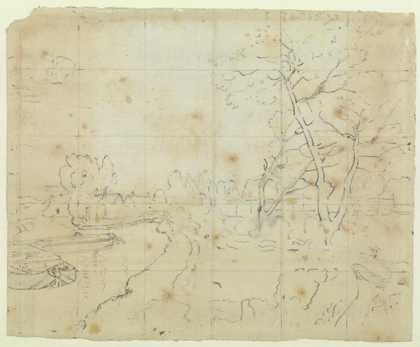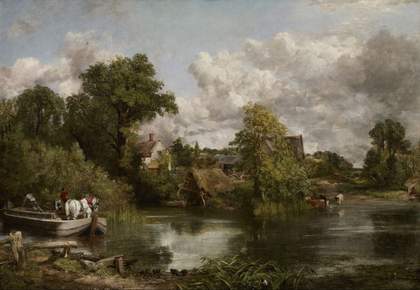
John Constable
The White Horse 1819
Copyright The Frick Collection
Constable’s ‘six-footers’
I do not consider myself at work without I am before a six-foot canvas
John Constable, 1821
As John Constable’s professional ambitions increased, so did the size of his canvases. Many of his earlier paintings are small as he painted out-of-doors and the canvases needed to be small enough to carry around. But in around 1819 he began to paint on a much larger scale, and through the 1820s he produced a sequence of six-foot paintings – or ‘six-footers’, of which Salisbury Cathedral from the Meadows 1831 was the last. Perhaps part of the reason he painted these huge paintings was to help them stand out at crowded Royal Academy exhibitions. But also, by painting such vast canvases, Constable was asserting his belief in the importance of landscape, then generally considered an inferior form of art.
The paintings all depict incidents in the working life of the River Stour, usually shown at noon. The White Horse 1819, (the first of the ‘six-footers’) shows a horse being ferried across the river. It was a critical success and Constable was voted an Associate of the Royal Academy on the strength of it. The Hay Wain 1821, with its focus on the hay cart under dense clusters of clouds, evokes a specific midday moment as the vehicle turns towards the distant fields.
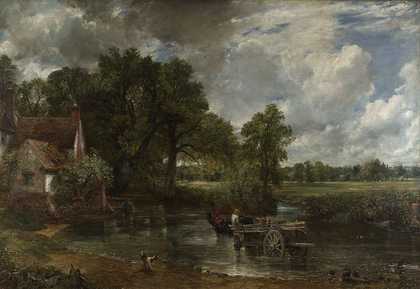
John Constable
The Hay Wain 1821
Oil on canvas
Courtesy The National Gallery, London
Preparatory sketches
In preparation for these monumental six-footers Constable made full-size preliminary sketches in oil paint. These helped him to work out his composition and ideas before tackling the final canvas. This unique practice is unprecedented in the history of Western art, and one that has shown him to be distinctly ‘modern’ in his approach. Today these full-scale sketches are admired just as much as the final exhibition pieces.

John Constable
Stratford Mill (full-size sketch) c.1819
Oil on canvas
Courtesy the Yale Center for British Art, Paul Mellon Fund

John Constable
Stratford Mill 1820
Oil on canvas
Courtesy The National Gallery, London
The full-scale compositional sketch for Salisbury Cathedral from the Meadows would have been built up from several sketches and paintings made of the cathedral from different views. Significantly it does not include a rainbow, a key iconographical detail that Constable incorporated while working up the final piece.
Technique and application of paint
The way Constable applies paint is often unexpected; it may be piled up or scraped down, aggressively jabbed or tightly and precisely touched, spread with a knife, scratched with the end of a brush, splattered and smeared
Jonathan Clarkson, Constable, London 2010, p.211
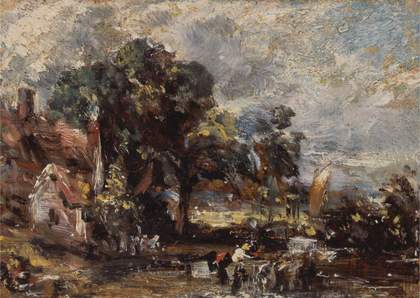
John Constable
Sketch for ‘The Hay Wain’ c.1820
Oil on paper on panel
Courtesy the Yale Center for British Art, Paul Mellon Collection
At the time Constable was working, the surface of a painting was expected to be refined and smooth, with brushstrokes as invisible as possible. But Constable wanted to create a range of marks, surfaces and textures to reflect the textures that he saw in nature and to add to the mood of the painting. He used a palette knife and brushes to create these expressive surfaces which are surprisingly varied: in some areas the paint is thick and craggy and in other places it is fluid and thin. Constable also added small smatterings of white paint to the surfaces of his paintings to suggest the flickering light across the landscape and its reflection off the surface of the water.
Constable’s lively mark-making contributes to the powerful impact of Salisbury Cathedral from the Meadows 1831. Take a closer look at the surface of the painting and discover some fascinating insights into Constable’s techniques and materials from Tate’s conservation specialists:
Critical responses
Although Constable’s expressive use of paint might appeal to us now, his technique was often criticized by his contemporaries. One complained that ‘he dots and dabs and grubs and splashes, more strangely in each succeeding year’; and the white flecks he used to suggest flickering light were disparagingly referred to as ‘Constable’s snow’.
When Salisbury Cathedral from the Meadows was first exhibited, it provoked critical reviews:
Somebody has spoiled [this landscape]…by spotting the foreground all over with whitewash. It is quite impossible that this offence can have been committed with the consent of the artist.
The Times, May 1831
The View of Salisbury Cathedral…appears to have been taken immediately after a snow storm…The numerous patches of dead white, intended for the lights of the picture, or perhaps for drops of rain after a shower, have all the chilling coldness of a winter’s morn.
The Gentleman’s Magazine, May 1831
Studio materials
After he died unexpectedly in 1837, the contents of Constable’s studio included four palettes, a wooden sketching box with brushes, chalk holder, palette knife and pigments in glass phials. There were also prepared canvases, easels and frames, and a wooden box full of bottles with colours. These provide us with an insight into Constable’s very personal working methods.
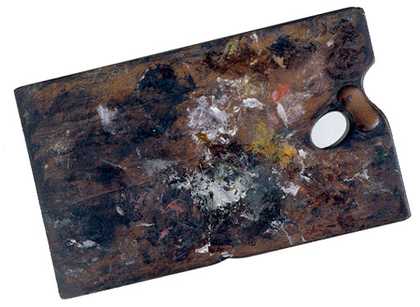
Constable’s palette c.1837
Reddish hardwood, traditionally cherry wood or walnut, though not identifiable by analysis
© Tate
This is one of the surviving palettes. It is covered with remains of colours such as vermilion, emerald green, chrome yellow, cobalt blue, lead white and madder, ground in a variety of mediums such as linseed oil mixed with pine resin. These can all be found on the surfaces of Constable’s later works, as translucent ‘glazes’ and crisp highlights.
His metal paint box of c.1837 is divided into seventeen compartments. It contains a cork-stopped glass phial with blue pigment, a lump of white gypsum probably used for a variety of purposes including drawing and roughening paper.
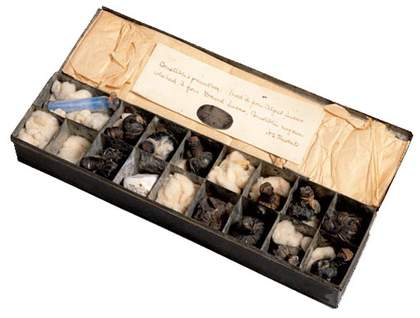
Constable’s metal paint box c.1837
Containing eleven paint bladders, a piece of white stone and a glass phial of blue pigment
Estate of Sir Edwin A.G. Manton
© Tate
The paint box also contains various paint bladders with the artist’s own or commercial ready-mixed paint. (Today oil paint is usually squeezed out of metal tubes, but these were only invented in the mid nineteenth century. When Constable was painting, paint bladders would have been used to store and carry oil paint. The bladders were made from pig membrane and tied at the top with strong twine to stop air from getting to the paint and drying it).
This mix of newly developed materials with more traditional ones that he prepared himself, meant that he was able to achieve very exact effects of colour and texture. He also used poppy oil to mix his pigments. As this was a slow-drying medium it allowed him to rework the surfaces of his paintings again and again over an longer period of time, before the paint dried.

